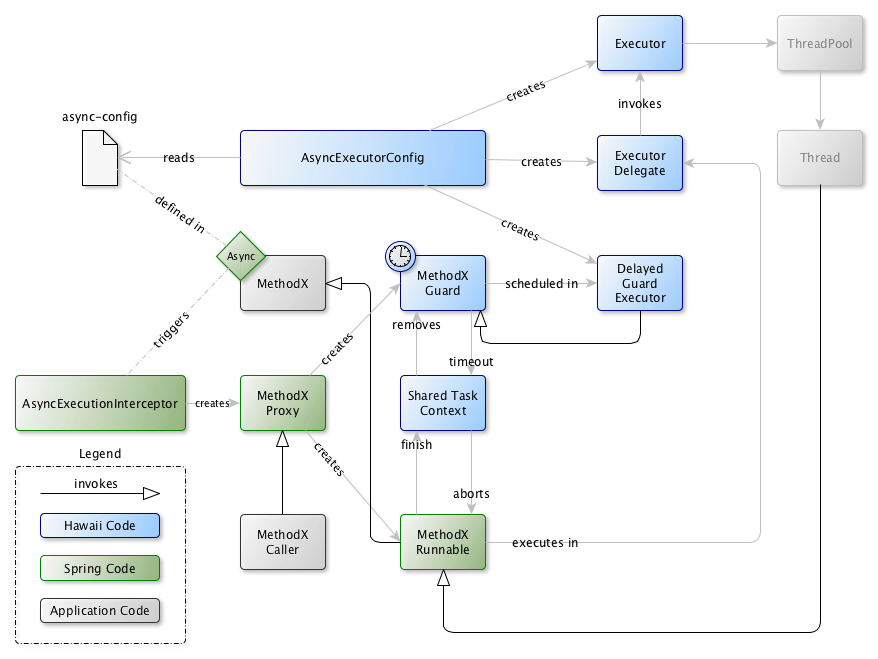Hawaii Starters
TODO.
hawaii-starter
TODO.
hawaii-starter-logging
The hawaii-starter-logging delivers a fully configured set of filters that are added to the filter chain in the configured order. The
starter contains a default configuration, which can be overridden by adding properties to your configuration. The default configuration
consists of the filters listed in the table below.
Filters with a negative order are added to the filter chain before any filters that modify or wrap the request and/or response. The UserDetailsFilter depends on Spring Security (it logs the authenticated Principal) and therefor has a higher order.
| Filter | Enabled | Order | Additional properties |
|---|---|---|---|
kibana-log |
true |
-108 |
|
kibana-log-cleanup |
true |
-110 |
- |
request-duration |
true |
-109 |
- |
request-id |
true |
-106 |
|
request-response |
true |
-105 |
|
transaction-id: |
true |
-107 |
|
user-details |
true |
110 |
- |
An example of the default configuration is available in the appendix.
How to use
In order to use Hawaii logging, you’ll need to define an appender that uses the KibanaLogEventEncoder, for example:
<appender name="kibana" class="ch.qos.logback.core.rolling.RollingFileAppender">
<file>log/idm-kibana.log</file>
<encoder class="org.hawaiiframework.logging.logback.KibanaLogEventEncoder"/>
<rollingPolicy class="ch.qos.logback.core.rolling.TimeBasedRollingPolicy">
<fileNamePattern>${tomcat_logs}/hawaii-idm.log.%d{yyyy-MM-dd}.gz</fileNamePattern>
<maxHistory>10</maxHistory>
</rollingPolicy>
</appender>hawaii-starter-rest
TODO.
hawaii-starter-test
TODO.
hawaii-starter-async
The asynchronous request execution in Hawaii is built on top of the scheduling in Spring Framework, see the Spring documentation for a baseline explanation.
There are two main additions:
-
More flexibility in executor configuration
-
Task timeout
Executor configuration
The Hawaii async configuration allows the definition of executors. An executor can be viewed as a thread pool. An executor configuration looks something like this:
executors:
-
name: default
corePoolSize: 10
keepAliveTime: 60
maxPendingRequests: 60
maxPoolSize: 60
The lowest level of configuration is a task. Tasks are grouped into systems. A system could be some backend system against which requests are executed, or a database on which queries are executed. Each request or query represents a task in Hawaii async terminology. System and task configuration looks like this:
systems:
-
name: mySystem
defaultExecutor: myExecutor
defaultTimeout: 3
tasks:
-
method: myTask
executor: mySpecialExecutor
timeout: 1
-
method: myOtherTask
As can be seen, an executor can be assigned on system level. This will be the default executor for all the tasks in the system,
unless a specific executor is configured for a task, such as myTask in the example. The same mechanism applies to the timeout settings.
It is therefore perfectly legal to configure a task without any properties. However, it remains necessary to define the task
in the configuration, otherwise it can’t be used, i.e. every task must be defined in the configuration.
Finally, there are some global properties:
defaultExecutor: default defaultTimeout: 10 asyncTimeoutExecutorPoolSize: 10
These define the default executor and timeout. These defaults will be used if no executor or timeout is defined on either task or system.
The asyncTimeoutExecutorPoolSize property defines the number of threads that are used to run timeout tasks.
See task timeout.
Task timeout
Another addition is automatically timing out tasks. For each task that is executed, the Hawaii async framework enqueues a cancellation task into a separate executor. If the timeout moment arrives, the timeout task is executed and will attempt to abort the actual task being executed. The actual task will remove the timeout task when it finishes, so if a task runs within its time limit, the timeout task will never be run.
Usage
In practice, using the Hawaii asynchronous framework is not that different from using Spring’s: asynchronous execution must be
enabled with @EnableAsync and methods that are to be executed asynchronously must be annotated with the @Async annotation,
and they must have a Future typed return value.
Additionally, an asynchronous configuration must be defined in the file identified by the hawaii.async.configuration property,
which is set to ./config/async-config.yml by default.
The essential difference in usage is that where Spring allows the specification of an executor by specifying the value of the
@Async annotation, the Hawaii additions require specifying the Task name instead of the executor. The Hawaii async configuration will
take care of routing the execution to the correct Executor.
HTTP
To execute http requests using the Hawaii async framework, you’ll need to use the HawaiiHttpComponentsClientHttpRequestFactory to enable
timing out of tasks that run too long.
You can use the LoggingClientHttpRequestInterceptor to log requests and responses made over http. Note that since this interceptor
consumes the response, this will only work if you wrap the HawaiiHttpComponentsClientHttpRequestFactory in a
org.springframework.http.client.BufferingClientHttpRequestFactory, or take other measures to make sure the response can be read
more than once.
Components
The following diagram shows the various components in the Hawaii async solution:

In the diagram, MethodX is the call that must be executed asynchronously, for example service or repository method. The @Async
annotation causes Spring to create a proxy around this method. The proxy locates the executor, which in the Hawaii case is a
DelegatingExecutor which will delegate to the real executor specified for the task. The executor takes the MethodX Runnable
and executes it on an available thread.
Additionally, a delayed (by the configured timeout) task, the MethodX Guard is created and passed to the Delayed Guard Executor.
Both tasks share the Shared Task Context which allows them to share logging context, and which also provides access for the
guarded task to remove the guard task upon completion, and for the guard task to abort the guarded task upon activation.
Processing
The sequence below shows the components working together to execute a task.
The sequence below shows the flow when a task times out.